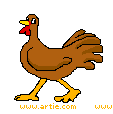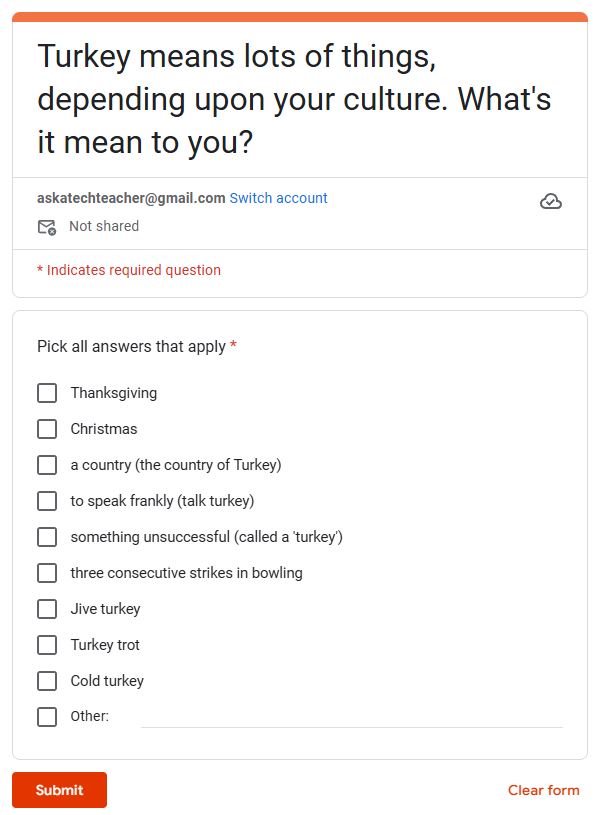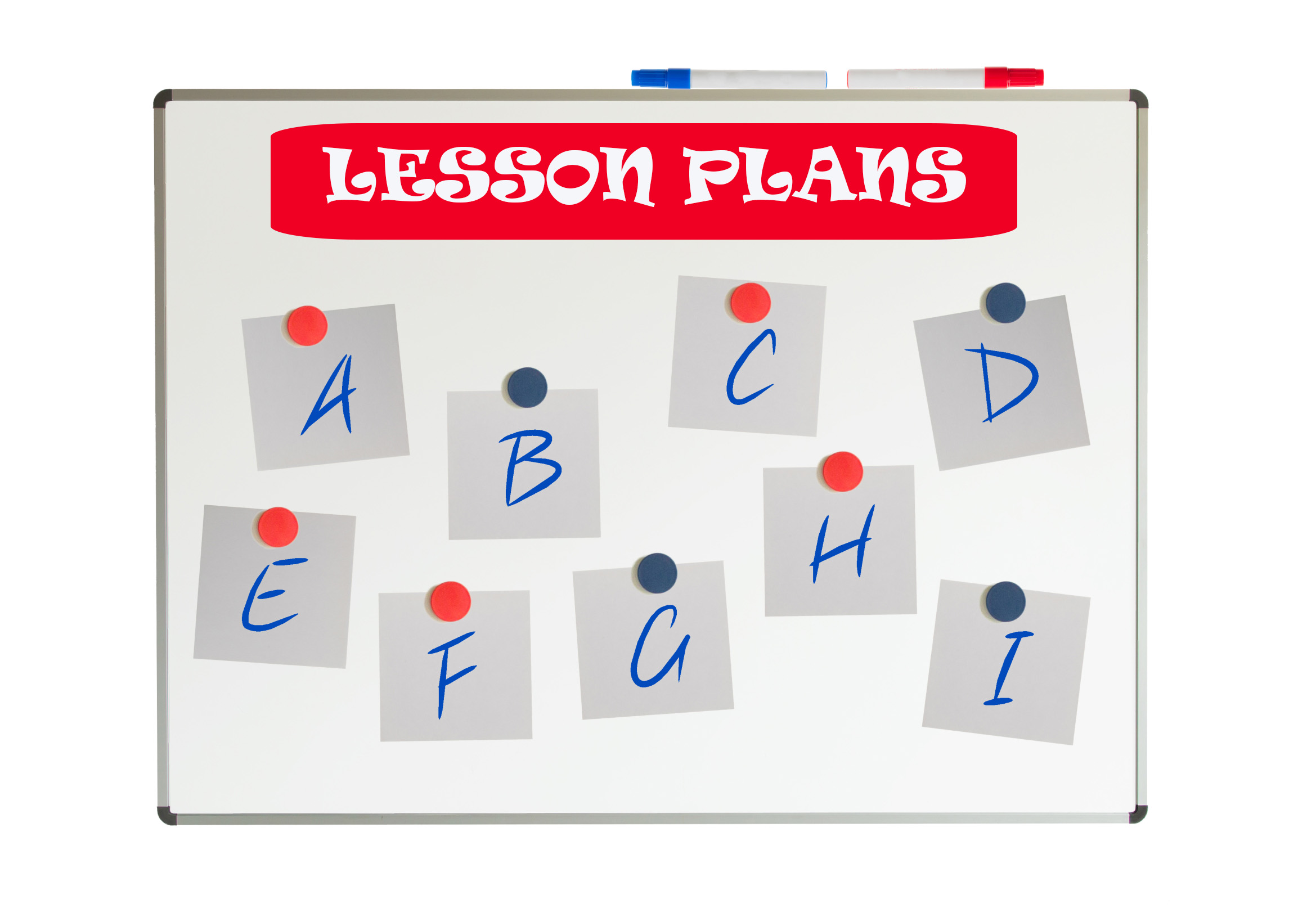Teaching the days before big holidays is challenging. Students and teachers alike are ready for a break. Both struggle to pay attention regardless of how innovative and engaging are the lesson plans.
I’ve been there often. As a result, I’ve come up with fun ways to support learning while students power through the last few days of school. Here are seven I use during the pre-Thanksgiving season:
- ASCII Art
- Comics
- Holiday Widget
- Team Challenge
- Thanksgiving Poll
- Thinking Games
- Themed
ASCII Art
Time required: Less than one class
ASCII Art is the graphic design technique of creating images by typing the letters, numbers, and symbols defined by ASCII Standards. Holiday examples include this Thanksgiving pumpkin and these holiday bells. Here’s how you do it:
- Open your word processing program (MS Word, Google Docs, or another).
- Add a watermark of a picture you’d like to use, preferably a single image rather than one that includes a background. Silhouettes are perfect for this sort of project.
- Type over the image with the letters, symbols, and numbers that best fit the outline. It’s fine to use one letter throughout (like an X).
- Add color by highlighting the letters, numbers, and symbols typed over the parts you’d like colored (such as the stem of a pumpkin or the bow on Christmas bells in the linked samples above).
- When you’ve covered the image with characters, delete the watermark. That leaves just your typing.
- Save, print, share, publish as is customary in your classes.
Tie-ins: Use this not only for holidays but any academic class by creating an artistic image of the topic being discussed. Click the link for an example of Abraham Lincoln to align with study of the American Civil War or this one of the American Revolution. This is also a fun and authentic way for students to practice keyboarding.
Comic
Time required: One class
Comics are a timely visual medium for digital storytelling done in a way that resonates with students. It’s equally appropriate for fiction and nonfiction and does a solid job of reinforcing Common Core standards related to writing, literacy, and language.
Here is how to use comics in your classes:
- Open the comic creator you use in your class. It may be one like Storyboard That!, Pixton, or another that you prefer.
- Comics can be used to tell a story, carry on a discussion, provide a sequenced how-to, or write an essay. Tell students your expectations and other pertinent information. You may offer an example or rubric if those are available.
- Decide as a group or individually how many panels (the square boxes that relate a scene) will be allowed. The lower the grade level, the less panels you should expect.
- Panels may include images, text, bubbles, and captions. All detail must support the theme.
- Each panel will flow into the next, just as story paragraphs and scenes flow.
- When the student thinks they’re done, they will share their comic with a neighbor and fine-tune as needed.
- Print, share, or publish as is customary in your classes.
Tie-ins: Comics can support any academic subject and any popular form of writing.
Holiday Widget
Time required: Less than 30 minutes
For those unfamiliar with widgets, they are free personalized mini-apps that are easy to create. They can do almost anything from finding the weather in Brazil to finding the North Star in the sky. Their code can be copied into most blogs, wikis, and websites or used from the Wolfram-Alpha site.
Here’s how to create a widget
- Access the Gallery (use this link) and search the available widgets; select one like these related to the holiday (you may have to query ‘holiday’) or another of your choice. There are many.
- Personalize for colors, output, and any other available options.
- Copy the code and embed it into your website, blog, or wiki. You can also share it to most social media.
Tie-ins: A widget can apply to any holiday or class event. A great option also is to program one of the widgets for an Hour of Code activity.
Team Challenge
Time required: 1.5 classes
This is a fun team activity to assess student knowledge on a topic. Take half of one class to let students organize their team, review questions, strategize, and prepare for the Challenge, which will take all of the next class. The Challenge can be played unplugged (no computer required), as a Jeopardy Game, through Kahoot, or using a similar gameshow format of your choice. We’ll use the unplugged approach today.
Here’s how it works:
- Break the class into teams.
- Pass out the questions (organized by categories) that will be part of the Team Challenge. These will be a summative review of everything you want them to know on the topic.
- Give students time to strategize the best way to compete. For example, they may decide to assign experts on each category or make everyone a generalist. During this prep time, teams will also select a captain who will be the only team member allowed to answer questions during the Challenge.
- On Challenge Day, Team #1 selects a category. Ask a question within that category. Give the team five seconds to answer. If they can’t, proceed to Team #2 but don’t repeat the question. If they can’t answer, move to Team #3 and then Team #4.
- Regardless of who answers the first question, Team #2 gets the next question. Teams must select from a category that hasn’t been used before.
- Teams score one point per correct answer. At the end of the Challenge, the team with the most points gets a prize appropriate to your school culture.
Students love this game. If I had time, I’d play it every grading period.
Tie-ins: This is an excellent gamified review for semester tests, final exams, or other summative assessments. Because it can be played unplugged, it’s great for days when computers are broken or not available.
Thanksgiving Poll
Time required: Minimal
Create a poll in Google Forms or another favorite. List as many definitions of the word “turkey” as you can think of and ask students to check off all those familiar to them. This may include a bird, a holiday, a country, something unsuccessful, to speak frankly, three consecutive strikes in bowling, and more. Here’s an example of what I include.
Post the poll on your class screen, class blog or website, or school blog or website. Students can complete it anytime during the school day. When the poll ends, share the results with students and discuss.
Tie-ins: Besides obvious connections to language and literacy, this is great to generate a conversation about symbols, idiomatic expressions, geography, science, culture, and more.
Thinking Games
Time required: Optional
Pre-holiday school days are great for supporting school goals surrounding Habits of Mind, problem-solving, and critical thinking with websites that focus on those skills. Here are some of my favorites:
- Math Pickle – put students in a chaotic situation and see how they solve the problem
- Quandary – challenge students ethically in this MIT game
- The Crossing – student attempts to cross a gorge and experiences failure as well as success
Themed
Time required: Optional
Don’t forget the ever-popular Thanksgiving-themed education-oriented websites and apps. They are good choices for sponge times, class warm-ups and exit tickets, and when nothing else cerebral seems to work. Here are favorites:
- Berenstein Bears Give Thanks (app)
- Canadian Thanksgiving

- Online/Offline Thanksgiving activities
- Plimoth Plantation–a field trip of a Pilgrim’s life. Included on this real-life site is a video of the Pilgrim’s crossing to the New World.
- Thanksgiving edu-websites–CybraryMan
- Thanksgiving Games
- Thanksgiving games and puzzles
- Thanksgiving games–Quia
- Thanksgiving Lesson Plans
- Turkey Templates — activities in Google Slides
When kids are too excited to concentrate, teaching is more about adapting to their needs than capitulating. Using these seven suggestions, you can make sure the learning continues even as Thanksgiving pulls their attention away.
Here’s the sign-up link if the image above doesn’t work:
https://forms.aweber.com/form/07/1910174607.htm
“The content presented in this blog are the result of creative imagination and not intended for use, reproduction, or incorporation into any artificial intelligence training or machine learning systems without prior written consent from the author.”
Jacqui Murray has been teaching K-18 technology for 30 years. She is the editor/author of over a hundred tech ed resources including a K-12 technology curriculum, K-8 keyboard curriculum, K-8 Digital Citizenship curriculum. She is an adjunct professor in tech ed, Master Teacher, freelance journalist on tech ed topics, and author of the tech thrillers, To Hunt a Sub and Twenty-four Days. You can find her resources at Structured Learning.








































Those seem like fun activities. The ascii-art looked interesting. In Swedish Turkey is Kalkon, which means just the bird Turkey. There is a rarely used slang word “Kalkon”, which means that something was a fiasco, such as a really bad movie.
Interesting, Thomas. You’ll love the Thanksgiving Poll–“What does Turkey mean?” I didn’t include your Kalkon–I will next time.